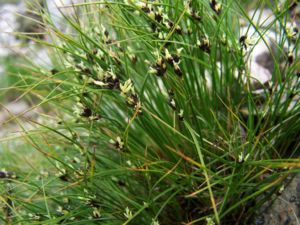Three-leaf bulrush
| Three-leaf bulrush | ||||||||||||
|---|---|---|---|---|---|---|---|---|---|---|---|---|

Three-leaf bulrush ( Juncus trifidus ) |
||||||||||||
| Systematics | ||||||||||||
|
||||||||||||
| Scientific name | ||||||||||||
| Juncus trifidus | ||||||||||||
| L. |

The three-leaf rush ( Juncus trifidus , syn .: Oreojuncus trifidus ), also known as the three-column rush , belongs to the rush family (Juncaceae). It is a pronounced cold indicator and occurs mainly in the higher regions of the mountains on rocks and in crevices.
Systematics
According to K. Kiffe (2000), two subspecies are distinguished in Germany, the common three-leaf rush ( Juncus trifidus L. subsp. Trifidus ) and the little-flowered three-leaf rush ( Juncus trifidus subsp. Monanthos (Jacq.) Asch. & Graebn. ). According to J. Kirschner et al. (2002) are both separate species, Juncus trifidus L. and Juncus monanthos Jacq. . The species are separated in both the Swiss and Austrian flora . According to J. Kirschner (2013), the three-leaf rush is also placed in its own genus: Oreojuncus trifidus (L.) Záv.Drábk. & Kirschner .
Distribution and location
The three-leaf bulrush is common throughout Europe. In southern Europe it occurs only in the mountains between 1600 and 3000 meters above sea level . It is also native to Asia as far as Siberia, Greenland and the eastern United States. In Germany, the species occurs only in the East Bavarian border mountains and in the Alps in a few locations. In the Allgäu Alps, it rises in the Tyrolean part of the Jöchelspitze from 2100 meters above sea level to about 2200 meters at the summit.
It grows on rocks, in crevices and in dry, poor lawns ( dwarf shrub heaths and grass grass ) and in small snow valleys . It is a species of the genus Juncetea trifidi.
description
The three-leaf rush is a perennial , evergreen hemicryptophyte that forms small clumps or lawns that are 10 to 30 (-40) centimeters high . The stems grow upright. They are thread-thin about 0.5 to 0.8 millimeters thick, hardly grooved and only slightly hairy, round and equipped with non-veined leaf sheaths at the base. The basal leaf sheaths are straw yellow to light brown and slightly shiny. They have no spreader or have a very short blade up to 1 centimeter long. The gray-green leaves are also very thin and semi-cylindrical with deep grooves. At the mouth of the leaf sheaths, ears 2 to 4 millimeters long, almost down to the base, are formed with eyelashes slit into three parts. There are no ligules.
The inflorescence is a two- to four-flowered spiral . It is clearly surmounted by two to three bracts . The red-brown tepals are 3 to 5 millimeters long. They have a green central nerve and are slender and long, pointed. They surround six stamens and three white recurved stigmas . The capsule fruit is red-brown and has a long tip. It is always shorter than the flower envelope.
The number of chromosomes is 2n = 30.
ecology
The flowers are pollinated by the wind ( anemophilia ). As a light plant, the three-leaf bulrush does not tolerate any shade. It is a cold pointer. In the mountains it occurs only in subalpine to alpine altitudes. Their ecological focus is on dry to fresh, low-nitrogen to low-nitrogen, low-lime but never strongly acidic soils in alpine lawns, crevices and on scree.
Sources and further information
Individual evidence
- ↑ K. Kiffe: Juncaceae. In: Henning Haeupler , Thomas Muer: picture atlas of the fern and flowering plants of Germany (= the fern and flowering plants of Germany. Volume 2). Published by the Federal Agency for Nature Conservation. Ulmer, Stuttgart 2000, ISBN 3-8001-3364-4 .
- ↑ Kirschner, J. et al. (2002). Juncaceae. Species Plantarum: Flora of the World 6-8: 1-237, 1-336,1-192. Australian Biological Resources Study, Canberra. Royal Botanic Gardens KEW
- ↑ Rafaël Govaerts (ed.): Juncus trifidus. In: World Checklist of Selected Plant Families (WCSP) - The Board of Trustees of the Royal Botanic Gardens, Kew . Retrieved October 12, 2016.
- ↑ Distribution worldwide according to Den virtuella flora; Area map based on von Hultén [1]
- ↑ Erhard Dörr, Wolfgang Lippert : Flora of the Allgäu and its surroundings. Volume 1, IHW, Eching 2001, ISBN 3-930167-50-6 , p. 297.
- ^ Erich Oberdorfer : Plant-sociological excursion flora for Germany and neighboring areas . With the collaboration of Angelika Schwabe and Theo Müller. 8th, heavily revised and expanded edition. Eugen Ulmer, Stuttgart (Hohenheim) 2001, ISBN 3-8001-3131-5 , pp. 147-148 .
- ↑ http://mobot.mobot.org/W3T/Search/ipcn.html Index to Plant Chromosome Numbers (IPCN)
- ↑ H. Ellenberg, H. E. Weber, R. Düll, V. Wirth, W. Werner, D. Paulißen: Pointer values of plants in Central Europe. Scripta Geobotanica 18, Verlag Erich Goltze, 1992. ISBN 3-88452-518-2
literature
- U. Graf: Sour grasses. Provisional key for the determination of non-flowering sedges, rushes and other sour grasses in Switzerland (Cyperaceae, Juncaceae, Juncaginaceae, Scheuchzeriaceen) : Juncus trifidus [2]
- J. Grau, BP Kremer, BM Möseler, G. Rambold & D. Triebel: Gräser , Mosaik-Verlag, Munich 1996, ISBN 3-576-10702-9
Web links
- Three-leaf bulrush. In: FloraWeb.de.
- Three-leaf bulrush . In: BiolFlor, the database of biological-ecological characteristics of the flora of Germany. Juncus trifidus s. l.
- Profile and distribution map for Bavaria . In: Botanical Information Hub of Bavaria .
- Thomas Meyer: Data sheet with identification key and photos at Flora-de: Flora von Deutschland (old name of the website: Flowers in Swabia )
Distribution maps
- Distribution in Germany
- Juncus trifidus L., map for distribution in Switzerland In: Info Flora , the national data and information center for Swiss flora .
- Distribution in the northern hemisphere according to Eric Hultén
- Distribution in North America
